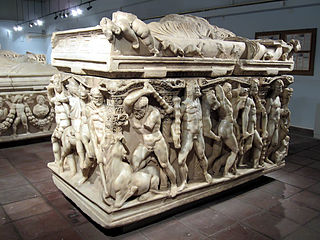Related Research Articles
Acmonia or Akmonia is an ancient city of Phrygia Pacatiana, in Asia Minor, now known as Ahat Köyü in the district of Banaz, Uşak Province. It is mentioned by Cicero and was a point on the road between Dorylaeum and Philadelphia. Under the Romans, it was within the conventus iuridicus of Apamea.
Sozopolis in Pisidia, which had been called Apollonia (Ἀπολλωνία) and Apollonias (Ἀπολλωνίας) during Seleucid times, was a town in the former Roman province of Pisidia, and is not to be confused with the Thracian Sozopolis in Haemimonto in present-day Bulgaria.

Apamea Cibotus, Apamea ad Maeandrum, Apamea or Apameia was an ancient city in Anatolia founded in the 3rd century BC by Antiochus I Soter, who named it after his mother Apama. It was in Hellenistic Phrygia, but became part of the Roman province of Pisidia. It was near, but on lower ground than, Celaenae (Kelainai).
Orcistus or Orkistos was a city originally in the northeast of ancient Phrygia and later a bishopric in the Roman province of Galatia Secunda, situated south of the town now called Ortaköy and previously Alikel Yaila.

Nyssa was a small town and bishopric in Cappadocia, Asia Minor. It is important in the history of Christianity due to being the see of the prominent 4th century bishop Gregory of Nyssa. Today, its name continues to be used as a titular see in the Eastern Orthodox Church and the Roman Catholic Church.
Synaus or Synaos, also spelled Synnaus or Synnaos (Σύνναος), was a city in the Roman province of Phrygia Pacatiana, now Simav, Kütahya Province, Turkey.
Polybotus or Polybotos was a city in the Roman province of Phrygia Salutaris. Its site is located 3 miles (4.8 km) southwest of Bolvadin in Asiatic Turkey.
Arabissus or Arabissos, also known as Tripotamos, was a town in ancient Cataonia, then Cappadocia, and later in the Roman province of Armenia Secunda. The Byzantine Emperor Maurice was born there in 539. A cave of the Seven Sleepers is located in the Eshab-ı Kehf Kulliye.

Tiberiopolis was a town in the Roman province of Phrygia Pacatiana, mentioned by Ptolemy, Socrates of Constantinople and Hierocles. At various times, it was considered as part of Phrygia, Isauria, and the late Roman province of Pisidia.
Attuda or Attouda was a Hellenistic city in ancient Caria and later in the Roman province of Phrygia Pacatiana. There are coins of the place with the Greek epigraph Ἱερὰ Βουλὴ Ἀττουδέων, of the time of Augustus and later. The coins show that the Men Carus was worshipped there.
Cidyessus or Kidyessos was a city of some importance, west of Ammonia in west-central ancient Phrygia, in the territory of the Setchanli Ova, or Mouse Plain; this large and fertile valley projects far into Phrygia Salutaris, but the city was in Phrygia Pacatiana.
Traianopolis, Trajanopolis, Tranopolis, or Tranupolis was a Roman and Byzantine city in Phrygia Pacatiana Prima.
Trapezopolis or Trapezoupolis (Τραπεζούπολις) was a city of ancient Caria, and later in the late Roman province of Phrygia Pacatiana Prima.
Augustopolis in Phrygia was a city and bishopric in the Roman province of Phrygia, which remains a Latin Catholic and an Orthodox titular see.
Comba or Komba was a city in ancient Lycia.
Daldis, was a town on the borders of ancient Lydia and Phrygia, a former bishopric, and is now a Latin Catholic titular see. It also minted coins in antiquity with the legend Δαλδιανων. It also bore the name Flaviocaesaria or Phlabiokaisareia, which is not attested among ancient authors but is reconstructed from epigraphic and other evidence.
Vasada was a city of ancient Lycaonia and later of Isauria, Asia Minor. It was located a little to the southwest of Laodiceia. In the acta of church councils attended by its bishop, the name appears variously as Usada or Ousada (Οὔσαδα) or Aasada (Ἀάσαδα).

Isinda was a town of ancient Pisidia.
Dioclea or Dioklea, Dioclia or Dioklia, Diocleia or Diokleia, was a town of ancient Phrygia, inhabited during Roman and Byzantine times.
Sebaste was a town of Phrygia Pacatiana in ancient Phrygia, inhabited in Roman and Byzantine times. It was located between Alydda and Eumenia. It became the seat of a Christian bishop, mentioned by Hierocles, and in the Acts of the Council of Constantinople, which its bishop attended. No longer a residential bishopric, it remains, under the name Sebaste in Phrygia, a titular see of the Roman Catholic Church.
References
- 1 2 Richard Talbert, ed. (2000). Barrington Atlas of the Greek and Roman World . Princeton University Press. p. 62, and directory notes accompanying.
- ↑ Michel Lequien, Oriens christianus in quatuor Patriarchatus digestus, Paris 1740, Vol. I, coll. 807-810
- ↑ Sophrone Pétridès, v. 1. Alia, in Dictionnaire d'Histoire et de Géographie ecclésiastiques, vol. II, Paris 1914, col. 442
- ↑ Annuario Pontificio 2013 (Libreria Editrice Vaticana 2013 ISBN 978-88-209-9070-1), p. 829
- ↑ Catholic Hierarchy
- ↑ GCatholic
- ↑ Lund University. Digital Atlas of the Roman Empire.